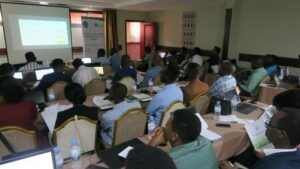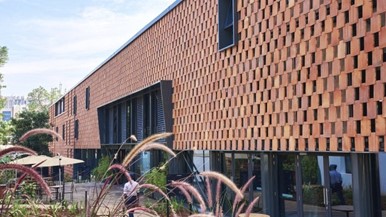By Dheeraj Arrabothu, Senior Green Building Specialist, and Africa Regional Lead for Green Buildings and Industries at GGGI
The construction sector accounts for approximately 40% of global CO2 emissions. About half of the emissions are attributed to building operations and the remaining half to the production of construction materials, also known as embodied emissions.
Although Rwanda, or any other developing country is the least responsible for climate change, these economies are facing the consequences of climate change the hardest. There is a huge climate risk for countries like Rwanda that can derail the growth momentum due to the disastrous floods and landslides experienced in mid this year. At the same time, countries like Rwanda are poised to grow in terms of population, urbanization, and rising incomes that drive demand for better housing, schools, hospitals, offices, hotels, and retail buildings. The demand for space is a source of carbon emissions, and there is an opportunity to ensure that building construction takes on more sustainable practices.

I&M Bank Headquarters – An example of a green building
Considering these challenges posed by climate change, the Rwandan government prioritized a model of economic development that is low-carbon and climate-resilient balancing environmental sustainability with economic growth thereby achieving poverty reduction and social inclusion in its development vision and strategies. Rwanda’s policy framework for the building and construction sector underscores the benefits of green/ sustainable buildings. In the context of Rwanda, a green building is a building that promotes energy efficiency by employing passive design principles and takes advantage of Rwanda’s favorable climate, promotes water efficiency, protects the environment, promotes indoor environmental quality, maximizes the use of locally produced and sustainable building materials, and able to withstand the impacts of extreme weather events.
In 2017, Rwanda Housing Authority in collaboration with the Global Green Growth Institute, the Building Construction Authority (BCA) of Singapore, Rwanda Green Building Organization (RwGBO), and other stakeholders, initiated the development of the Green Building Minimum Compliance System (GBMCS). a baseline for green buildings tailored to suit the country’s context and was approved by the Rwandan cabinet in April 2019 through a ministerial order determining the Urban Planning and Building Regulations and is an Annex-3 to the Rwanda Building Code of 2019. GBCMS also contributes towards Rwanda’s SDG targets.
The GBMCS is a point-based system that was made mandatory in 2023 for all Category 4[1] and Category 5[2] public buildings. Since April 2019, GGGI supported RHA in continuous awareness-raising and capacity-building programs through the celebration of World Green Building Weeks, animation adverts in national media, presentations in Rwanda Institute of Architects (RIA) and Institution of Engineers Rwanda (IER) symposiums. Notably, an Excel-based was developed to support the building designers in demonstrating compliance to the system and assist the district One Stop Centre (OSC) staff to assess the building permit applications in terms of the degree of compliance. To date, more than 300 professionals have been trained on the GBMCS system including hands-on training to use the excel templates. It is estimated that 100% adoption of GBMCS will result in cumulative emission reduction of 5.64 MtCO2e by 2030.

One of the capacity building workshops for professionals on GBMCS
The cost of going ‘green’ is often cited as one of the barriers by multiple stakeholders. The incremental cost of green measures can be considerably reduced if the intent to construct a green building starts right from the design stage. Passive design principles such as proper orientation of the building, better space planning, daylighting, natural ventilation, and using existing site features will incur no additional cost using an integrated approach during the design stage. Going green as an afterthought will be expensive and is not ideal. In addition, banks are also encouraging developers to construct green buildings. For example, Ireme Invest a strategic initiative of the Government of Rwanda led by the Development Bank of Rwanda to address the financing gaps in green and climate-resilient projects. BRD is using the GBCMS as one of the benchmarking tools to finance green housing projects and the projects are expected to meet at least 80 points of the total 190 points in the GBMCS to receive concessional financing.
Going forward
Awareness, Capacity Building, Continuous monitoring and improvement – Since GBMCS is a mandatory requirement for all Category 4 and 5 public buildings there is a need for continuous capacity building for practitioners and building permitting/inspection officers on the requirements of the GBMCS and the application of the indicators. Awareness must be raised especially among building owners, real estate developers and financing institutions on the benefits of green buildings. GBMCS has been conceived as a green building code and there lies the opportunity to modify and upgrade the requirements in the GBMCS based on continuous monitoring and feedback from implementation.
A green building rating – A green building rating system provides an opportunity for buildings to demonstrate a higher level of certification going beyond the minimum requirements of the GBMCS. Currently, several green building rating systems are being pursued by various projects including LEED, EDGE, Green Mark, Green Star, WELL, etc. There is also an opportunity to develop Rwanda’s very own green building rating system tailored to suit the unique needs and the context of the country. The rating system can be built on the GBMCS system by increasing the thresholds, adding new indicators, and introducing tiers for certification. This needs to be associated with the development of processes and procedures for issuing green building certificates, identification, and training of independent auditors to verify compliance, capacity building of professionals on the rating system, and development of tools to ease the process of achieving the certification.
Green and climate-resilient affordable homes – As Rwanda is trying to address the affordable housing deficit it is important to ensure that the affordable housing projects integrate green building and climate resilience measures during the design and construction stages. This will ensure that the end users of these houses would incur reduced operational costs for running those homes and enhanced resilience to withstand the impacts of climate change. The GBMCS is designed to address the requirements in non-residential buildings and there is an opportunity to develop a simplified GBMCS to cater to the requirements of affordable housing and residential projects at large.
Locally manufactured, affordable, and low-carbon building materials and technologies – A steady supply of affordable, low-carbon building materials, and green technologies are key for the design and construction of green buildings. The potential for materials such as timber, agro-waste boards, clay bricks, earthen blocks, stone, bamboo need to be fully realized through enhanced access to finance for micro, small and medium-scale producers, workforce management, standardizing production processes. Strengthening local production using low-carbon technologies has the potential to create green jobs for the youth.
Green construction finance and incentives – New innovative financing instruments and incentives need to be developed to support the development of green buildings. Incentives can be both fiscal and non-fiscal such as tax subsidies for green building material & technologies, concessional loans, recognition, and acknowledgement of green buildings, to name a few. Supply driven financing initiatives such as Ireme Invest for increasing green affordable housing supply and demand driven financing initiatives such as the Rwanda Housing Finance Project of World Bank to expand access to housing finance to households are aimed to address some of the gaps. Rwanda needs more of such initiatives to support the development of green buildings.
Category 4 building is a building with three-stories and above accommodating not more than 500 people. The category 4 comprises of towers and antennas, all types of buildings, except for industrial buildings and hazardous buildings.
Category 5 comprises of sports and leisure facilities, social, cultural, assembly and religious buildings, health facilities, educational buildings or other buildings that accommodate more than five hundred (500) people.
The Author is an Architect, planner and green building specialist with the Global Green Growth Institute based out in Kigali, Rwanda. Dheeraj Arrabothu is a Senior Green Building Officer and the Africa Regional Lead for the Green Buildings & Industries (GBI) Communities of Practice (CoP). He is a project manager and leads business development, project implementation, policy development, capacity building and supports climate finance mobilization to develop a green built environment.

